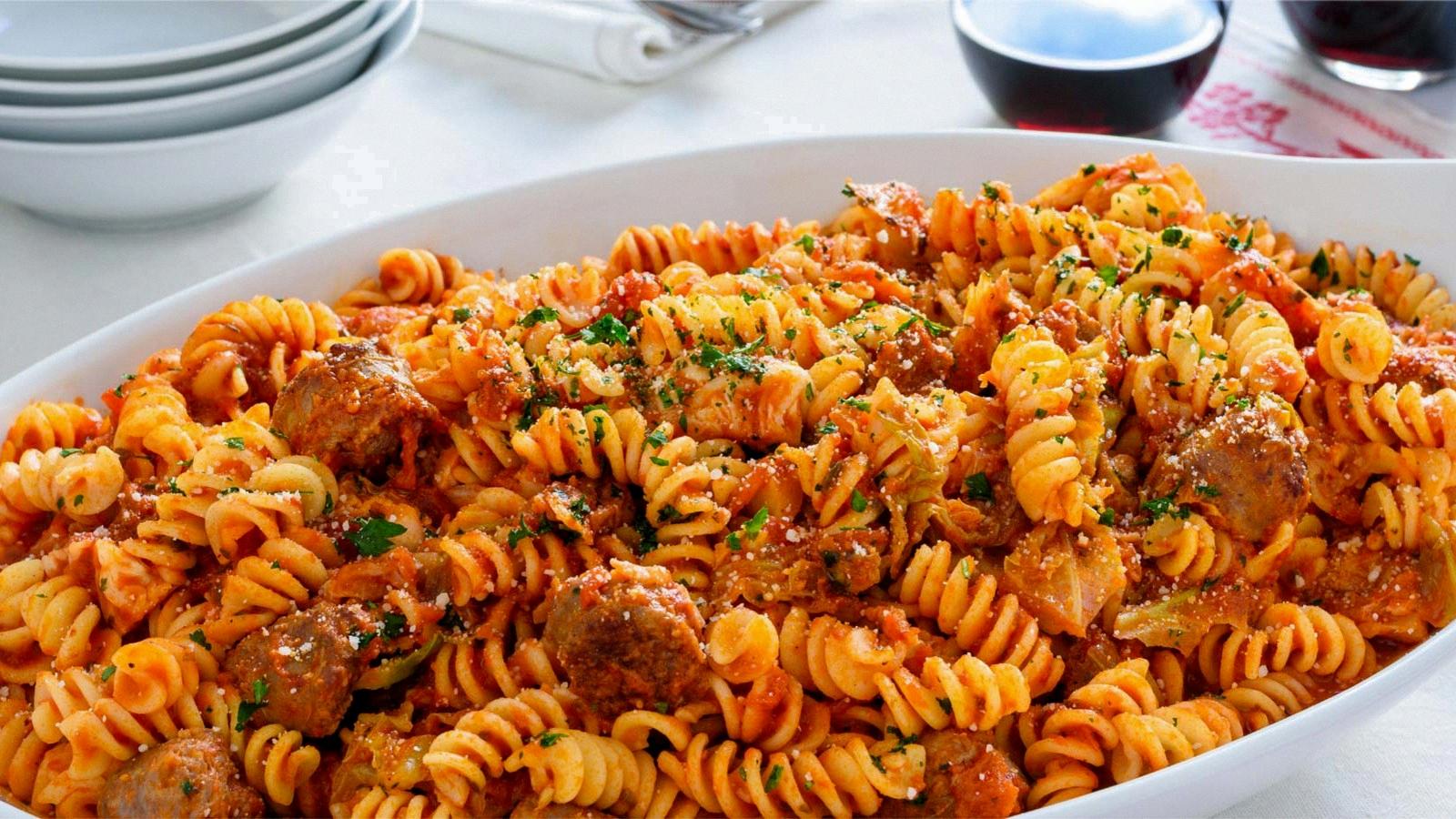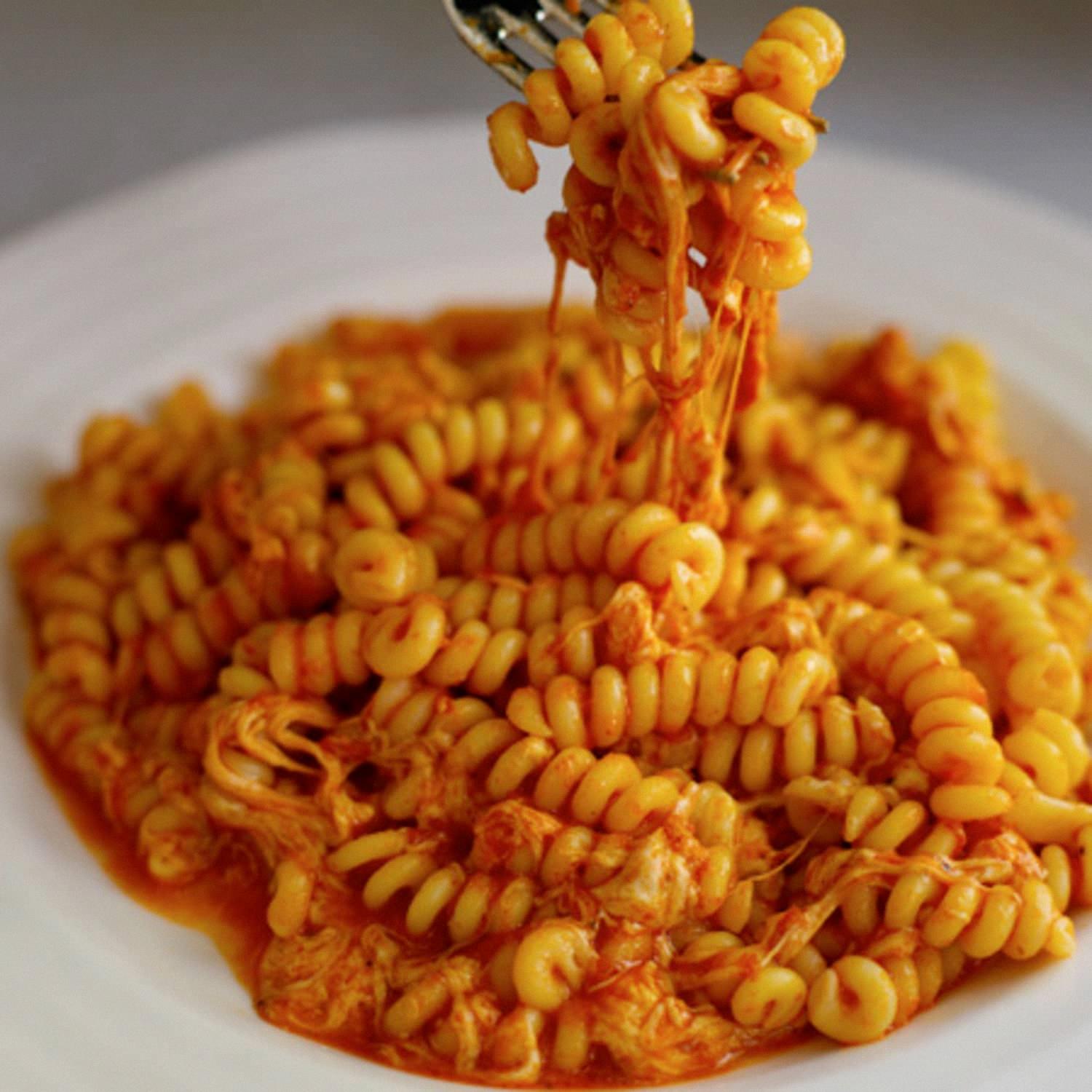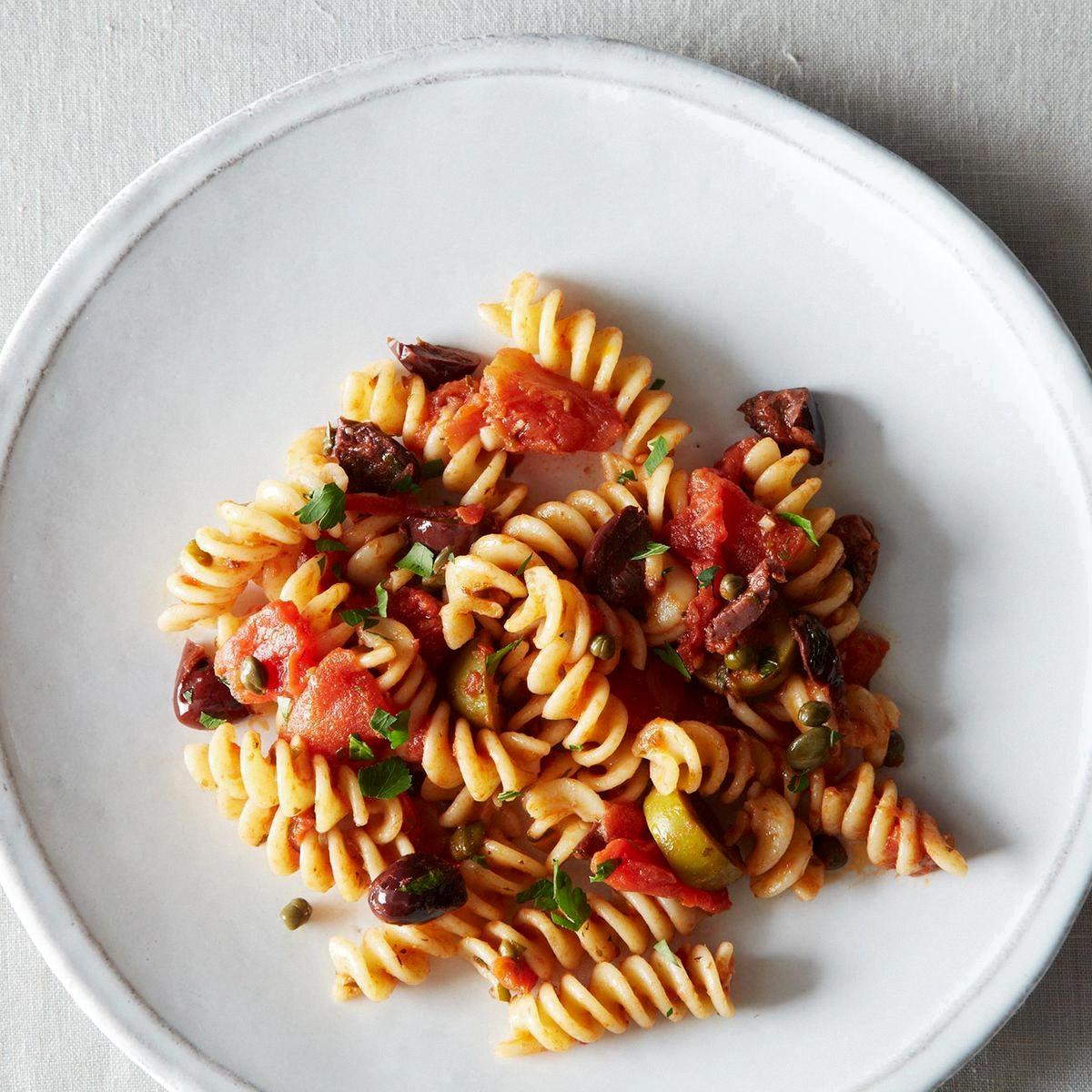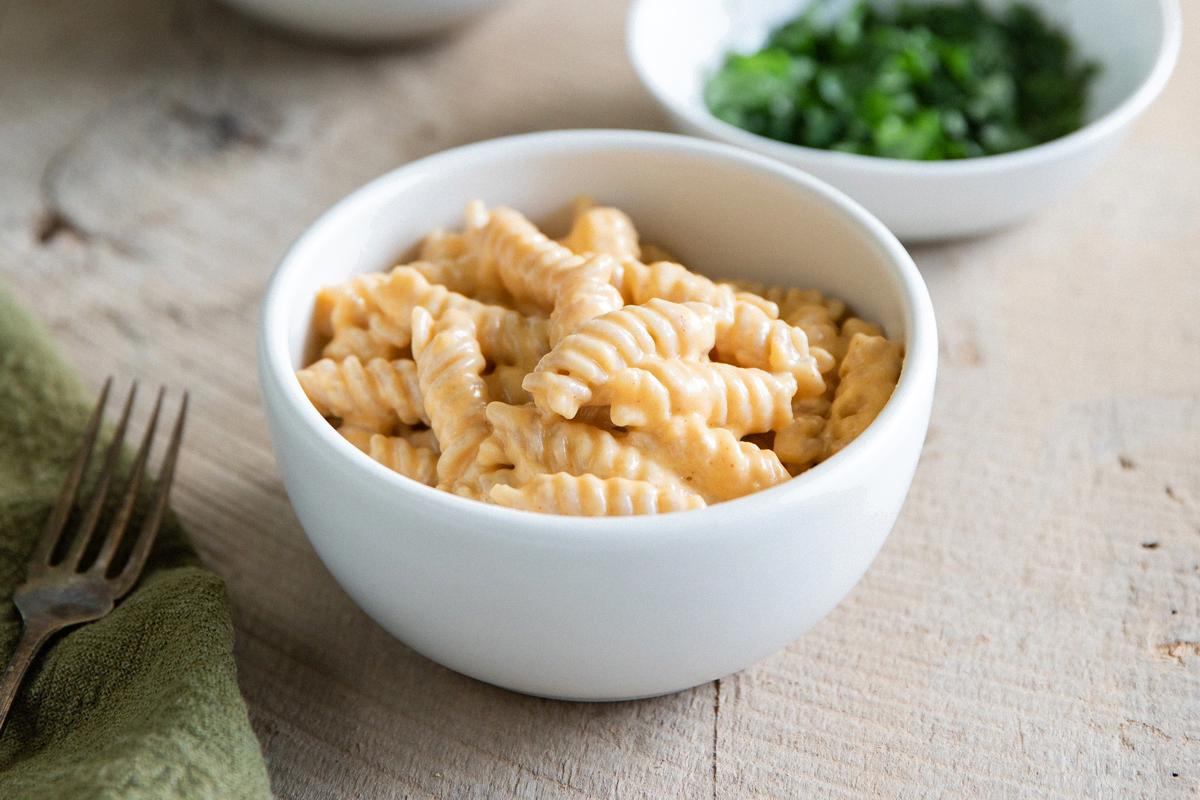When it comes to pasta, there are endless varieties to choose from. Two popular options are fusilli and rotini. They may look similar, but there are some key differences between the two. In this article, we’ll explore the characteristics of each and provide some tips on when to use them in your cooking.
Fusilli
Fusilli is a spiral-shaped pasta that is perfect for holding onto rich and creamy sauces. Its corkscrew shape helps to trap sauce in the grooves, making each bite flavorful and satisfying. Fusilli is also versatile and can be used in a variety of dishes, from pasta bakes to salads.
When it comes to cooking fusilli, it’s important to keep in mind that it can easily become overcooked and mushy. To avoid this, cook it al dente, or until it’s just tender but still slightly firm in the center. This will help to maintain its shape and texture.
Possible substitutes for fusilli include rotini and spirals, both of which have similar shapes and textures.
Rotini
Rotini is another spiral-shaped pasta that is often used interchangeably with fusilli. However, there are some differences to consider. Rotini has a tighter spiral and is slightly smaller in size, making it an ideal option for heartier, thicker sauces like ragu. Its ridged texture also helps to capture more sauce, making each bite more flavorful.
When cooking rotini, it’s important to keep in mind that its tighter spiral can make it more prone to clumping together. To prevent this, stir the pasta occasionally while cooking and rinse it with cold water after draining to prevent it from sticking together.
Possible substitutes for rotini include fusilli and spirals of similar size and shape.
Spirals
Spirals are a type of pasta that come in a variety of shapes and sizes, including fusilli and rotini. As ther name suggests, they have a spiral shape that makes them perfect for holding onto sauce. They are also versatile and can be used in a variety of dishes, including pasta salads, one-pan dishes, and more.
When cooking spirals, it’s important to follow the instructions on the package to ensure they are cooked to perfection. Over-cooking can cause them to become mushy, while under-cooking can leave them tough and chewy.
Both fusilli and rotini are excellent options for pasta lovers. Each has its own unique characteristics that make it ideal for certain dishes. Fusilli is perfect for holding onto rich and creamy sauces, while rotini is better suited for heartier, thicker sauces. Spirals of similar size and shape can be used interchangeably with both. The key to cooking each pasta to perfection is to follow the instructions on the package and to keep in mind their unique characteristics.
Uses for Fusilli Pasta
Fusilli pasta is a versatile pasta shape that can be used in a variety of dishes. Its unique spiral shape makes it well-suited for holding onto rich and creamy sauces, which is why it’s often used in pasta dishes with cream-based sauces, such as Alfredo sauce or carbonara sauce.
Fusilli pasta is also popular in pasta salads, as its shape alows it to hold onto dressings and other ingredients. It can also be used in one-pan dishes, such as casseroles or skillet meals, where it can be combined with other ingredients to create a complete meal in one dish.
In addition, fusilli pasta can be used in pasta bakes, where it’s combined with other ingredients, such as cheese, vegetables, or meat, and baked in the oven for a delicious and comforting meal.
Fusilli pasta is a versatile and delicious pasta shape that can be used in a variety of dishes, making it a pantry staple for many home cooks.

Source: raos.com
Which Type of Pasta Best Retains Sauce?
When it comes to pasta, not all shapes are created equal. Certain types of pasta are better at holding onto sauce than others. The key is to choose a shape that complements the texture and consistency of your sauce.
Tubular shapes like penne and ziti are popular choices for sauces with chunks of meat or vegetables. The ridges on these pasta shapes help to capture the sauce, giving each bite a burst of flavor. Rigate, the ridged ones, are especially good at holding onto thick, hearty sauces like ragu.
For creamy sauces, wider, flatter pastas like fettuccine and pappardelle are ideal. The wide surface area of these noodles helps to sop up the sauce, resulting in a rich and decadent bite. Other options for creamy sauces include conchiglie, or shell-shaped pasta, and farfalle, or bow tie pasta.
For lighter sauces, spaghetti and linguine are great options. Their long, thin shape allws the sauce to evenly coat each strand, creating a harmonious balance of flavors. Angel hair pasta is also a popular choice for light sauces, as its delicate texture allows it to easily soak up the sauce.
The type of pasta that holds sauce best depends on the texture and consistency of the sauce. Tubular shapes like penne and ziti are ideal for thick, hearty sauces, while wider, flatter pastas like fettuccine and pappardelle are better for creamy sauces. Spaghetti and linguine are great options for lighter sauces.
What Sauce Is Best Paired with Fusilli?
Fusilli is a popular pasta shape that is known for its twisted and spiral shape. This shape of pasta is versatile and pairs well with various sauces. However, to make the most of the shape, it is best to pair it with sauces that can cling to the twists and crevices of the pasta.
One sauce that works exceptionally well with fusilli is pesto. This is a light and smooth sauce made with basil, garlic, pine nuts, parmesan cheese, and olive oil. The sauce clings well to the twists and turns of the fusilli, making each bite flavorful and delicious.
Apart from pesto, you can also pair fusilli with tomato-based sauces like marinara or arrabbiata. These sauces are hearty and add a punch of flavor to the pasta. You can also try cream-based sauces like Alfredo or Carbonara, which add a rich and creamy texture to the pasta.
When it cmes to vegetables, you can pair fusilli with sautéed spinach, roasted broccoli, or grilled zucchini. These additions not only add a healthy twist to the dish but also enhance the flavor profile of the pasta.
Fusilli is a versatile pasta shape that pairs well with a variety of sauces. From pesto to tomato-based sauces to creamy sauces, the possibilities are endless. So, get creative in the kitchen and experiment with different sauces to find your perfect match.
Types of Pasta Used for Mac and Cheese
When it comes to classic macaroni and cheese, the pasta used shold be a short, cylindrical extruded pasta, commonly referred to as macaroni. This pasta style encompasses a variety of tube-shaped pastas, including penne, ziti, rigatoni, and the quintessential elbow macaroni. Corkscrew-shaped pasta, such as fusilli, can also be used. It is essential to note that the pasta used should have a shape that can hold onto the creamy cheese sauce, making for a delicious and satisfying dish. any type of short and cylindrical pasta can be used to make macaroni and cheese, allowing for a variety of options to suit personal preferences.
The Benefits of Rotini as the Best Pasta
Rotini is considered one of the best pasta shapes due to its unique twisted shape. The spiral-like shape of rotini allows it to hold onto sauces incredibly well, compared to most other pasta shapes. The curves and ridges of this pasta shape provide a perfect surface for sauces to cling to, ensuring that each bite is coated in delicious flavor.
Rotini is versatile and can be paired with a variety of sauces and ingredients. It pairs best with thick, smooth sauces, such as Alfredo or marinara sauce. The shape of rotini also makes it ideal for salads, casseroles, and stir-frys. Its spiral shape can hold onto dressings, cheeses, and other complementary ingredients, making it an ideal choice for pasta salads.
Rotini is also a great option for thoe who want to add more vegetables to their diet. The twists and turns of the pasta can easily catch and hold onto veggies, such as peas, carrots, and broccoli, making it a perfect base for a healthy and nutritious meal.
Rotini is the best pasta due to its unique shape, which allows it to hold onto sauces and other ingredients exceptionally well. It is a versatile pasta that can be used in a variety of dishes, making it a staple in many households.

Source: thekitchn.com
What is the Italian Name for Rotini?
Rotini is a popular type of pasta that is known for its spiral, corkscrew-like shape. In Italy, this type of pasta is actually known as “fusilli.” This name is commonly used throughout Italy and is the original name for this type of pasta.
Fusilli is made from durum wheat flour and water, and is typically served with a variety of sauces and toppings. It is a versatile pasta that can be used in a wide range of dishes, from classic Italian pasta dishes to more modern creations.
While the name “rotini” is commonly used in some parts of the world, it is important to note that this is simply a different name for the same type of pasta. If you are looking to cook with fusilli, be sure to look for this name on the packaging when purchasing pasta at the grocery store.
Rotini is called “fusilli” in Italy, and is a delicious and versatile pasta that can be used in a variety of dishes. Whether you prefer classic Italian recipes or more modern creations, this pasta is sure to be a crowd-pleaser.
The Benefits of Fusilli for Mac and Cheese
Fusilli is an excellent pasta choice for mac and cheese recipes. This type of pasta is known for its spiral shape, whih allows it to hold onto a lot of cheese sauce. Additionally, the texture of fusilli is perfect for mac and cheese, as it is firm enough to hold up to the sauce but also tender and chewy.
When cooking fusilli for mac and cheese, be sure to follow the instructions on the package carefully. Fusilli can take a bit longer to cook than some other types of pasta, so make sure to give it enough time to cook through. Once cooked, drain the pasta and add it to your cheese sauce, stirring gently to coat the pasta evenly.
One of the great things about using fusilli in mac and cheese is that it is versatile and can be paired with a variety of cheese sauces. Whether you prefer a classic cheddar cheese sauce or something a bit more adventurous, such as a spicy pepper jack sauce, fusilli can handle it all.
If you are looking to switch up your mac and cheese recipe, consider using fusilli. Its unique shape and texture make it a great pasta choice for this classic dish.
Which Type of Pasta is Best for Pasta Salad: Fusilli or Rotini?
When it comes to pasta salad, the type of pasta you choose can make a big difference in the overall taste and texture of the dish. While both fusilli and rotini are popular choices for pasta salad, there are some differences between the two that may make one a better option than the other.
Fusilli pasta is often characterized by its spiral shape, which makes it a popular choice for dishes that require a pasta that can hold onto sauces and dressings. This is because the ridges and twists in the pasta help to trap the sauce, which allws for a more flavorful and cohesive dish. Additionally, fusilli is often made with durum wheat, which gives it a slightly nutty flavor and a slightly chewy texture.
Rotini pasta, on the other hand, is a corkscrew-shaped pasta that is also great for pasta salad. Like fusilli, rotini has ridges and twists that help to hold onto sauce and dressing. However, rotini is often made with a blend of semolina and durum wheat, which gives it a slightly softer texture and a milder flavor than fusilli.
So, which pasta is better for pasta salad? Ultimately, it comes down to personal preference. If you prefer a pasta with a slightly nutty flavor and a chewy texture, then fusilli may be the better choice for you. However, if you prefer a pasta with a softer texture and a milder flavor, then rotini may be the way to go.
Here are some other factors to consider when choosing between fusilli and rotini for your pasta salad:
– Size: Fusilli pasta is typically slightly larger than rotini, which can be a consideration if you want a more substantial pasta in your dish.
– Color: If you’re looking for a colorful pasta salad, then fusilli may be the way to go. It’s often available in a variety of colors, including red, green, and yellow.
– Availability: Both fusilli and rotini are widely available at most grocery stores, so availability shouldn’t be an issue when choosing between the two.
Both fusilli and rotini are great choices for pasta salad, and the choice between the two ultimately comes down to personal preference. Consider factors like size, color, and texture when making your decision, and don’t be afraid to experiment with different types of pasta to find the one that works best for your taste buds.
Why Fusilli Is The Best Pasta Choice
Fusilli is a popular pasta shape that has been enjoyed by people all over the world for generations. There are several reasons why fusilli is considered the best pasta. Let’s explore these reasons in detail:
1. Shape: The spiral shape of fusilli pasta is perfect for holding onto sauces. The grooves and crevices in the helix shape provide ample space for sauce to cling to the pasta, making each bite flavorful and delicious.
2. Versatility: Fusilli pasta is versatile and can be paired with a wide range of sauces. It is equally suitable for light, thin sauces as well as for hearty meat sauces. This versatility makes it a great choice for any meal.
3. Texture: The springy texture of fusilli pasta is a delight to eat. It has a satisfying bite that makes it enjoyable for those who love to chew their food.
4. Fun factor: The twisted shape of fusilli pasta is considered fun to eat by many people, especialy children. The unique shape of the pasta adds an element of playfulness to the meal.
5. Availability: Fusilli pasta is widely available in most grocery stores and supermarkets, making it a convenient choice for people who want to whip up a quick and easy meal.
Fusilli pasta is considered the best pasta because of its shape, versatility, texture, fun factor, and availability. It is a great choice for any meal, and its unique shape makes it a favorite among many pasta lovers.

Source: food52.com
Health Benefits of Fusilli Pasta
Fusilli pasta is a type of pasta that is shaped in a spiral or corkscrew shape. It is a popular pasta shape and is commonly used in a variety of dishes. But the question is, are fusilli pasta healthy?
Fusilli pasta is made from durum wheat semolina, which is a high-protein flour. It is also available in whole wheat form, which is even healthier. Whole wheat fusilli pasta is a better choice becaue it is high in fiber, which is good for digestion and helps to reduce the risk of heart disease.
Here are some of the health benefits of fusilli pasta:
1. Lowers Cholesterol Levels: Whole wheat fusilli pasta is rich in dietary fiber, which helps to lower cholesterol levels in the body. This, in turn, reduces the risk of heart disease.
2. Helps to Regulate Blood Sugar Levels: The fiber in whole wheat fusilli pasta helps to slow down the absorption of glucose in the bloodstream, which helps to regulate blood sugar levels.
3. High in Vitamins and Minerals: Fusilli pasta is rich in vitamins and minerals such as iron, magnesium, and zinc, which are essential for good health.
4. Helps with Weight Loss: The fiber in whole wheat fusilli pasta helps to keep you feeling full for longer, which can aid in weight loss efforts.
When it comes to serving fusilli pasta, be mindful of the portion size and the accompanying sauce. Opt for a tomato-based or vegetable-based sauce, rather than a cream-based sauce, which can be high in calories and fat.
Fusilli pasta can be a healthy addition to your diet, especially when made from whole wheat. It is high in fiber, vitamins, and minerals, and can help to lower cholesterol and regulate blood sugar levels. So, go ahead and enjoy a delicious bowl of fusilli pasta without any guilt!
What Type of Pasta is Best for Alfredo Sauce?
When it comes to pairing pasta with Alfredo sauce, the best option is fettuccine. This long, flat noodle has a wide surface area that allows for the sauce to coat it evenly, resulting in a rich and creamy pasta dish.
Fettuccine is also a thick pasta, which helps it hold up well to the heavy, creamy sauce wihout becoming mushy or falling apart. The thickness of the noodle also helps prevent it from clumping together in the bowl, ensuring that each bite is delicious and enjoyable.
When making homemade Alfredo sauce or any creamy sauce, it’s important to use a pasta that can stand up to the richness of the sauce. Fettuccine is ideal for this, as its hearty texture and structure can handle the weight of the sauce without becoming too soft or losing its shape.
In addition to fettuccine, other pasta shapes that work well with Alfredo sauce include linguine, pappardelle, and tagliatelle. These noodles are similar in shape and thickness to fettuccine, making them great options for creamy pasta dishes.
When it comes to choosing a pasta for Alfredo sauce, fettuccine is the clear winner. Its thick, flat shape and wide surface area make it the perfect vehicle for rich and creamy sauces, resulting in a delicious and satisfying pasta dish.
Does Olive Oil Assist in Adhering Sauce to Pasta?
Olive oil is a commonly used ingredient when cooking pasta, and it is often believed to help sauce stick to the pasta. However, there is some debate over whether or not olive oil actually helps with this.
Some people blieve that adding olive oil to the cooking water can prevent the pasta from sticking together and also prevent the pot from boiling over. However, most experts agree that this is not the case. In fact, adding olive oil to the cooking water can actually make the pasta too slippery and prevent the sauce from sticking to it.
When it comes to adding olive oil to the sauce itself, there is also some debate. While some believe that adding a small amount of olive oil to the sauce can help it adhere to the pasta, others argue that this is unnecessary and can actually negatively impact the flavor of the dish.
The general consensus is that olive oil is not necessary for helping sauce stick to pasta. Instead, it is recommended to simply cook the pasta in salted water until it is al dente, and then toss it with the sauce immediately before serving. This will ensure that the sauce coats the pasta evenly and creates a delicious and flavorful dish.
Gigi Hadid’s Choice of Pasta
In the recipe shared by Gigi Hadid, the pasta that was used is shell pasta. This type of pasta is known for its unique shape, whch features a hollow center and a curved exterior that resembles a seashell. The shape of shell pasta makes it perfect for holding sauces and other ingredients, as the sauce can get trapped inside the shells and create a burst of flavor in every bite.
Although shell pasta is the preferred pasta for this dish, it is also possible to use other types of pasta such as penne or bowtie pasta. However, it is important to note that the texture and taste of the dish may vary depending on the type of pasta used. For those who prefer a smooth texture, penne pasta may be a good alternative. On the other hand, bowtie pasta can add a touch of elegance to the dish with its unique shape.
Gigi Hadid used shell pasta in her recipe, which is a type of pasta known for its ability to hold sauces and other ingredients. However, penne or bowtie pasta can also be used as alternatives depending on personal preferences.

Source: jovialfoods.com
Conclusion
While fusilli and rotini may appear similar, they have distinct differences that can affect the outcome of your dish. Fusilli’s spiral shape and twisted ridges make it perfect for holding onto rich and creamy sauces, wile rotini’s corkscrew shape is great for trapping chunky vegetables and meat in its crevices.
When it comes to choosing between the two, the type of sauce you plan to use should be taken into consideration. If you’re using a thick, hearty sauce like ragu, tubular shapes like penne and ziti may be a better option, while wide and flat pastas like pappardelle are ideal for sopping up creamy sauces.
Ultimately, it comes down to personal preference and the dish you plan to make. Experiment with both fusilli and rotini to find which works best for you and your recipe.
